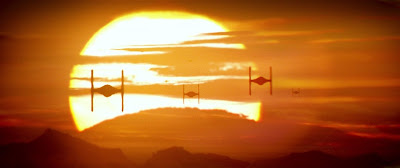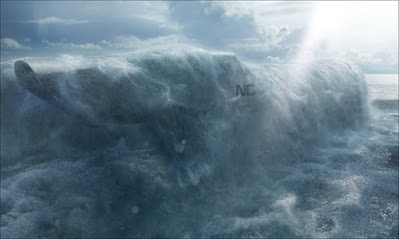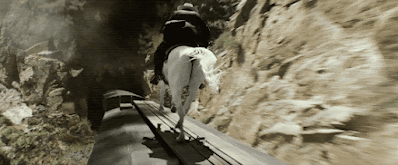Folks who follow me on Twitter (currently known as X) are probably aware of my years-old, depressing, frequently updated and repetitive thread pointing out studios and filmmakers downplaying or outright lying about the use of digital visual effects on their projects. "We did it all for real!" is the message given in interviews, production notes and featurettes. The truth is these movies frequently contain hundreds or even thousands of digital visual effects shots, and sometimes the sequences they're directly referencing are made entirely out of digital effects.
The typical pattern is as follows:
- Pre-release studio-driven featurettes and studio-provided production notes handed to journalists include the filmmakers stating that "real, practical" action is the proper way to film this kind of movie, implying that little or no digital visual effects are used because audiences can 'always tell'. The amazing stunt work, special practical effects and production design is heavily championed, and vague language is routinely utilized, ultimately implying that "no 'CGI' was used in this film". Reasonable people watch these clips and read the production notes will understandably conclude little or no digital visual effects were used in the film.
- The digital visual effects supervisors and artists working on these films see these featurettes on YouTube and scream into pillows.
- The social-media hype machine of YouTubers, Twitter users and TikTok'ers repeat the "no visual effects" mantra, which solidifies its "truth" even further. Variety, The Hollywood Reporter, CNN, local TV news, and mainstream media outlets repeat the myth, which feeds the social media folks even more.
- The movie is released and even though there are literally hundreds of visual effects professionals' names in the credits, the "no visual effects" chorus continues, this time by supporters of the film, and is weaponized in the form of "the movie was good because they didn't use 'CGI'", as in "this proves how practical effects are superior to 'CGI'".
- Weeks later, if studios allow visual effects people to discuss their work at all, visual effects supervisors talk to the tech press about the hundreds upon hundreds of visual effects that were used in the film (sometimes documenting how the very same stunts and sets that were championed in the featurettes were digitally augmented or were made fully from computer graphics techniques).
- At awards time, huge visual effects reels are seen by industry professionals and are mostly confidential.
- These films get nominated and win digital visual effects awards.
- The damage done to the truth is seemingly permanent. Even years after films' releases, some people still believe the mythology that there are no digital visual effects in movies like "Mad Max: Fury Road" and the recent "Mission: Impossible" films, and the phrase "practical is always better than 'CGI'" continues to thrive.
- The cycle begins again.
The visual effects industry is under attack from many sides, most significantly manifesting in working conditions, hours, burnout, exploitation of workers, unreasonable client expectations, unreasonable schedules, bad client design changes, bad client management, visual effects shops underbidding each other, fixed bids, only a handful of clients who pit the visual effects shops against each other, near-zero unionization amongst visual effects workers, no trade association for visual effects shops to leverage solidarity, uneven free money given to movie studios that destabilizes visual effects and creates false markets... I could go on.
The perpetual cycle of false mythology that these movies are made without digital visual effects adds insult to injury and feeds an already burning inferno.
• • •
Like me, visual effects artist Jonas Ussing has been paying attention and keeping receipts of these instances of "No CGI Mythology" over the last few years. Ussing has launched an amazing video series documenting some of the most extreme examples of actors, filmmakers and studios creating a false mythology about how their movies are made. Part 1 of his four part series is now online, and it's called "No CGI is really just Invisible CGI", and I suggest you all watch it.
In this day and age, when there are filmmakers out there like James Cameron, Martin Scorsese, David Fincher, Michael Bay, Zack Snyder and others proudly showing off the digital effects work in their movies, considering them valuable partners in the filmmaking process (and earning billions of dollars at the box office and awards and prestigious accolades in the meantime), it's absolutely bizarre that certain studios and filmmakers steadfastly maintain the idea that marketing a modern movie means highlighting physical production while outright lying about their use of digital visual effects - and indirectly and directly insulting an entire craft in the process.
And yet, it continues. Mere days after Ussing's video debuted, Sony released a featurette for "Gran Turismo" (2023) to promote the film's home video release. At less than ninety seconds in duration, the promotional featurette represents one of the most egregious and blatant examples I've ever seen of deceptive myth-building (ahem, lies) about how a specific movie was made.
• • •
Directed by Neill Blomkamp, who also directed the imaginative science-fiction epics "District 9", "Elysium" and "Chappie", "Gran Turismo" features several exciting racing sequences that were executed with stunt drivers, innovative camera rigs, drones and many other techniques to capture as much material practically with stunt performers and actors.
Oh, I forgot to mention, the movie also required over a thousand digital visual effects shots.
Before we get to the featurette, let's talk about the visual effects of the film. Most of the stories debuted, as they usually do, a week or two after the films' release, and the "Gran Turismo" visual effects press followed the same trend. The movie was released in the United States on August 25, 2023. Two weeks later on September 16, Befores and Afters published "Make them go Fast", which detailed the various visual effects challenges of the movie. Ian Failes interviewed VFX supervisor Viktor Müller about the computer graphics cars made for the film.
Here's a few example of live-action plates, and the final shot which features CG cars.
Here's an example of one of the performers in a special spinning rig, photographed against a greenscreen, for a crash sequence in the film.
All of this is preface to Sony's ridiculous featurette.
• • •
Premiering on YouTube on October 28, 2023, Sony's ninety second video promoting "Gran Turismo"'s digital release trumpets the physical production, and also plays heavily to the ridiculous marketing technique of repeating that "digital effects are inferior" and "only brave filmmakers shoot with practical effects".
Check out these whoppers that appear the video:
- The film's producer, Asad Qizilbash says, "He wanted to make it really practical and shot like in real life." [his quote has some obvious audio editing to splice together several different comments into a single sentence]
- Blomkamp: "The temptation is to go all digital. The cars could be animated. You could film the [racing] tracks as background plates and do digital cars, but in this case, everything is real." [again, obvious audio editing here]
- Actor Darren Barnet: "It's always a treat for an audience when something feels more real. Shooting this movie without green screens, without projectors, I think gives the more honest performance." [again, obvious audio editing here]
- Cinematographer Jacques Jouffret: "It's very practical."
- From the video's description: "No green screens. No projectors. That's just how Neill Blomkamp rolls."
Let's be clear - the director of the movie said "Everything is real", and no reasonable person would assume the filmmakers used "background plates and do digital cars" which is exactly what the director said they didn't do. "Practical" and doing it for "real". The video's description is less vague and far more direct: "No green screens. No projectors. That's just how Neill Blomkamp rolls."
In 2023, I can't believe we're still dealing with these ridiculous, obvious lies. "Gran Turismo" had over 1,100 digital visual effects - digital effects that producer Qizilbash and director Blomkamp asked for and directed. And paid millions of dollars for. But you'd never guess that from this featurette. Any reasonable person would assume, after seeing that studio-produced video, that no visual effects were used in the film.
What makes this especially egregious is this studio-driven erasure of visual effects (outright lies) was brazenly published after the visual effects press promoted the movie's digital effects. Typically, the pattern begins with the deceptive marketing occurring before the film's release, not after the film's release (and after in-depth reporting).
The whiplash sustained from the witnessing the intense contrast between the filmmakers' clear pride in the digital work on "Gran Turismo" and the studio-driven marketing of "we did it all for real" is staggering. And for those of us who care about the truth, the situations is quite demoralizing. The visual effects world is under attack from all angles, and it's deeply unsettling to get fired upon from one's own studio and filmmakers.
I'll say this as clearly as I can. Filmmakers and studios should be proud of every aspect of the filmmaking process. They should brag about their photography, their stunt work, their production design and physical sets, the amazing special practical effects. They should shout their pride and excitement from the rooftops. Filmmaking is a collaborative experience, and all crafts work together to achieve the director's vision. But there's no need to weaponize their enthusiasm of physical production against visual effects, with the ultimate goal of diminishing, erasing and outright lying about the project's use of post-production work.
Why do the studios think this is a winning strategy? That's another topic that's far too complicated to go into now. But a cursory look at the YouTube comments of the Sony featurette clearly illustrates that this marketing isn't working as well as studios think it is.
I'm really getting tired of studios and filmmakers telling the #CGLie. And others are, too.
Links:
























































